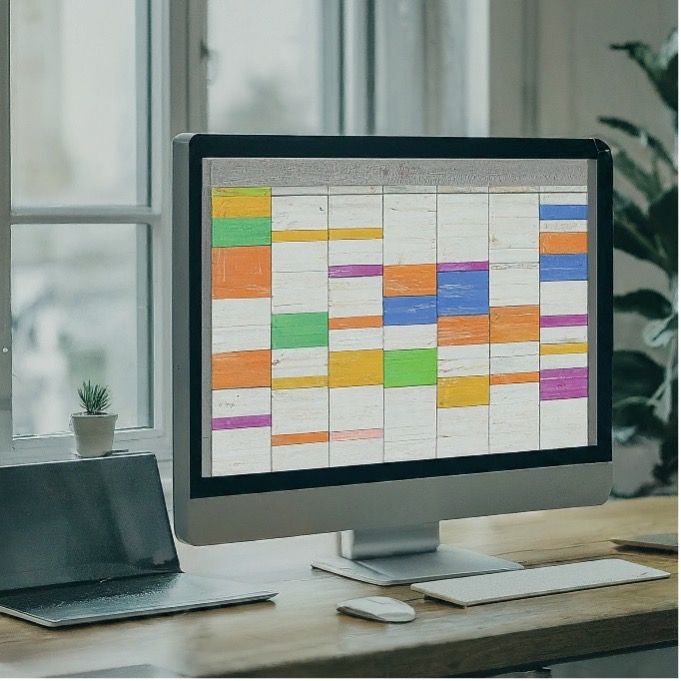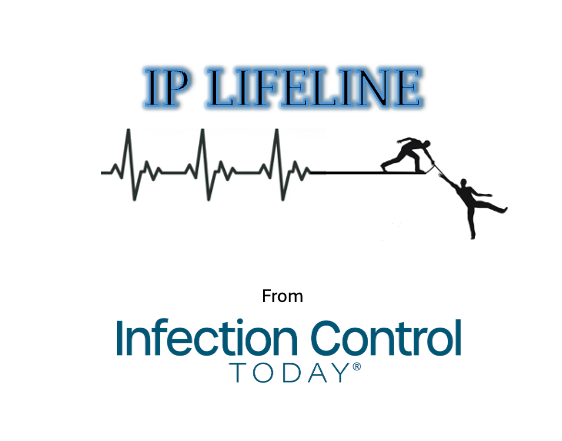How To Optimize Your Time Management Strategies for the Busy Infection Preventionist
Is your calendar resembling a chaotic masterpiece of overlapping tasks? Join the club of infection preventionists striving to balance responsibilities. Dive into proven strategies from a fellow infection preventionist to reclaim control of your time, streamline tasks, and boost productivity effectively. This is an IP Lifeline article.
A colorful calendar on a computer.
(Image credit: Brenna Doran, PhD, MA, ACC, CIC via AI.)

My calendar currently looks like a 5-year-old’s finger-painting project. It’s a colorful mixture of green, blue, orange, purple, and gray to help me differentiate between the numerous projects and responsibilities that ebb and flow throughout my life.
My to-do list is beginning to get lost around the second and third pages of my notebook, peering back mockingly at me for my inclination to take on more than my sanity might allow. As I wonder if I might be able to create another day in the week like some modern-day female version of Cronos, my email inbox dings with another message awaiting reply. Of course, the sender flagged it as urgent.
I laugh because I cannot shake the irony of it all. I’m sitting here with the cursor blinking on my screen, preparing to write an article on strategies for time management, as I am acutely aware of the clock ticking on the wall to my right. I’ve decided that you should know the truth and that I am just as determined as you are to control time.
If you’re reading this article, you’re probably in the same boat as I am. There is “too much to do and so little time,” so you’re looking for better strategies to manage your day.
But before we explore some tried and proper time management techniques, I must ask you: “Is it your time management skills that need improvement, or is it your ability to say no?”If we keep adding more and more work to our schedule, the problem changes from “poor time management” to “too much work.” This is just something to ponder as we seek to improve the productivity and efficiency of our workday.
On that note, let’s review 5 crucial steps to improve time management.
IP Lifeline From infection Control Today

Step 1: Study Your Work Habits
It only takes a quick Google search to be inundated with many strategies for time management. One could easily become overwhelmed by one's effort to find the “correct” strategy in a sea of opinions on which strategy produces the highest level of productivity. Yet, I’ve come to learn in my mission to gain mastery over my own time that no strategy will work for everyone. This quest to improve our relationship with time is simply one of trial and error. We seek to find what works best for us and keep trying until we find that one strategy that fits.
We are not all built the same, so it stands to reason that what works best for me will not work for you. I have tried many times to “eat that frog” at the beginning of my day but decided I desperately needed my coffee before diving into my day's deepest and most demanding tasks.
I also find frogs gross, but I digress.
Before you set out to find the strategy that works best for you, you must first study yourself.How do you work best, and when do you work best? Are you the type of person who wakes up ready to go first thing in the morning, or do you produce your best work in the afternoon? Do you thrive in chaos or with rigid structures? Your time management strategy will depend heavily on how and when you do your best work. So first, to thine own self be true.
Step 2: Audit your Workday
Once you know yourself forwards and backward, you can move on to better understanding your work. Knowing what tasks occupy your day-to-day is important to determine how best to accomplish them. Do you spend most of your working days in the trenches of deep work sessions, or are you busy completing dozens of small tasks throughout the day? Do you have categories of work that are always competing for your time (eg, emergency operations center rounds, antibiotics stewardship, education), or are you specialized and focused on only one specific task (eg, surveillance)? In this first stage of organization, you need to create a master list of everything you do to understand better where you’re spending your time. This is an essential step before organizing your work.
To identify tasks, projects, and job roles, you may need to track your work for a week or month. Keep a notebook and pen handy and write down how you spend your time in 15 to 30-minute time blocks. This should help you create a list of tasks and projects and make you more aware of how much time you spend responding to those emails. After completing your list, you should see themes or “buckets of work.”For example, your “buckets of work” may be major projects or job responsibilities.
Step 3: Work Smarter, Not Harder
After you’ve written a complete list of your jobs, tasks, and projects, it’s time to identify opportunities for streamlining processes. Missy Travis MSN, RN, CIC, founder of IP&C Consulting LLC, suggests we “examine the list of tasks to see if there are any processes we can change to make our work more efficient and save time. For example, could we create a standard report rather than recreating one each month or quarter? Or could we delegate any of the tasks on our list?”
I am a massive fan of templated emails, reports, and spreadsheets. Anything that can streamline my work and make it flow more seamlessly. My standard reports generally follow the same format, and weekly or monthly emails are a copy and paste from last month’s update, with some minor tweaks for new information. Always ask yourself, how might I make this task more automated and streamlined? Do you spend too much time sifting through emails to find the ones needing a response? Use the flagging function in your inbox to pin messages needing follow-up and folders to organize your emails.
Step 4: Organize your to-do lists
Now that you’ve created and refined your list of work, it’s time to organize what remains. Your buckets of work filled with associated tasks will serve as a framework for organizing to-do lists related to each major category of work. To-do lists have long been the gold standard for organizing tasks in the workday. Known to improve productivity, reduce stress, and give a sense of accomplishment, to-do lists are a fast friend for busy working professionals. To-do lists are also a great way to stay on top of tasks, ensuring that nothing gets forgotten in the work week.
Infection preventionist and project manager Lauren Geary, BS, RRT-NPS, CIC, says, “I’m a big fan of to-do lists. They help me prioritize and organize tasks that need to get done and keep track of unplanned tasks that may pop up throughout the week.”
To-do lists can be organized under your major “buckets of work,” allowing you to keep track of tasks under each project, responsibility, or role. Grouping tasks is beneficial when you’re trying to juggle multiple job responsibilities or major projects. Electronic to-do list managers are a great way to organize many tasks requiring follow-up.
Step 5: Prioritize. Prioritize. Prioritize.
Without prioritization, to-do lists can become overwhelming and overburdensome. It’s easy to jump from one task to another without fully completing them. For to-do lists to work for you, you need to manage your to-do list before it tries to manage you. This is accomplished through daily and weekly prioritization of your to-do list.
Infection preventionist Jennifer Langholz, BSN, RN, CIC, shares, “I make a to-do list for Monday and the upcoming week on Fridays, or before I leave for time off, so I can hit the ground running when I get back.” Prioritizing your to-do list requires knowing which tasks or jobs are most urgent and addressing these before attempting to address the tasks that can wait. Once you’ve identified which tasks to prioritize for the day or the week, schedule them into your calendar to set aside dedicated time to complete them.
Infection Preventionist and Employee Health Coordinator Jeannine Bordelon, BSN, RN, CIC, says, “Schedule everything. Use the calendar to your advantage. Keep track of appointments, audits, reporting, etc, to facilitate better time management and reduce nonvalue-added activities.”
This method is called “Time blocking.” It’s a particularly successful way to manage the multitude of tasks, projects, and job responsibilities that compete for your time. Time blocking requires scheduling chunks of time into your calendar to focus on specific projects, tasks, and job responsibilities. Often, I will block time in my calendar immediately after listing it in my to-do list to ensure time for follow-up. Time blocking your calendar also allows you to carve out uninterrupted time for deep work sessions. Infection preventionist Frankie Catalfumo MPH, CIC, CRCST, says, “I commit to “one hour of deep attention” every day. No use of my personal cellphone for texting, no scrolling, and no checking emails.”
Additional Strategies
It’s impossible to share all the strategies supporting healthy time management in one article. However, I sincerely hope this gives you a foundation to build upon as you examine additional strategies to improve your productivity and efficiency while reducing stress in your workday. After getting to know yourself and your work, you can continue evaluating possible tools to improve your time management.
Other tools to consider, such as “Eating that frog,” the Pomodoro Method, the Eisenhower Matrix, and the Pareto Principle, are other established methods for taking hold of your time and making it work for you instead of you working for it. Remember, this is not a one-size-fits-all. What works well for one person may not work well for the next. So, continue trying different strategies to improve time management until you find one that suits you best.
Always remember, when it feels like you never have enough time, take a moment to ask yourself if your time management strategy needs refining or your ability to say no to additional tasks and work.
“Ongoing Assault”: How HHS Layoffs Have Eviscerated Infection Prevention Support Across the Nation
April 1st 2025Mass layoffs at HHS and CDC have gutted critical infection prevention programs, leaving frontline professionals overwhelmed, under-resourced, and desperate to safeguard public health.
Together We Rise: Why AORN Expo 2025 Is a Must for Every Perioperative Nurse
March 31st 2025From April 5 to 8, 2025, thousands of perioperative nurses will gather in Boston for the 2025 AORN Global Surgical Conference & Expo—a transformational experience designed to elevate nursing practice, build lifelong connections, and advance surgical care.
Vet IP Roundtable 2: Infection Control and Biosecurity Challenges in Veterinary Care
March 31st 2025Veterinary IPs highlight critical gaps in cleaning protocols, training, and biosecurity, stressing the urgent need for standardized, animal-specific infection prevention practices across diverse care settings.